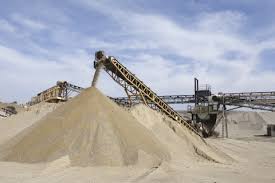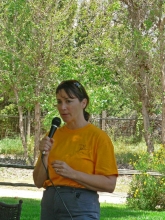 By Miriam Raftery
By Miriam Raftery
April 12, 2010 (Lakeside) –Concerns bubbled up at a Saturday meeting between Helix Water District general manager Mark Weston and residents of Lakeside over a proposed El Monte Valley mining, reclamation, and groundwater recharge project.
 “The problem is that we are losing water from the Colorado River and Northern California,” Weston said at the meeting, held at the Hazy Meadow Ranch. “Now we, like all water agencies, are looking at how to expand water supplies in our district.”
“The problem is that we are losing water from the Colorado River and Northern California,” Weston said at the meeting, held at the Hazy Meadow Ranch. “Now we, like all water agencies, are looking at how to expand water supplies in our district.”
Ninety percent of San Diego County’s water supply is imported. After nine years of drought along the Colorado River, supplies have lessened and the water itself has become more saline (salty). Meanwhile a federal court ruling has ordered a halt to delta pumping to protect fish, further restricting water supplies for southern California.
Helix has proposed to take wastewater that has been gone through standard tertiary treatments and filtered with 100% reverse osmosis, hydrogen peroxide, and ultraviolent treatment. The treated water would then be pumped into ponds along the north side of El Monte Valley and seep into the groundwater basis to mix with naturally occurring water. After six months in the ground, it could be pumped from wells on the south side of the valley and sent to  a treatment plant in Lakeside, where it would be treated with ozone to become drinking water.
a treatment plant in Lakeside, where it would be treated with ozone to become drinking water.
The plan would also allow sand mining in the valley a section at a time, followed by revegetation that Helix officials say would ultimately restore and enhance natural habitat for wildlife, adding hiking and riding trails and several river crossings.
“For the last three years, Orange County Water Treatment’s premier project through 100% reverse osmosis has been treating 70 million gallons a day—twice what we use in Helix,” Weston said. “This demonstrates that we can provide safe drinking water through reverse osmosis. Absolutely it removes everything that cause harm.”

The project could provide five million gallons of purified water per day, up to 15% of total water demand in the District, which includes La Meas, Spring Valley, Lemon Grove, El CAjon, parts of Lakeside and Santee, and some unincorporated areas of the County.
Helix has used El Monte Valley for well fields dating back 80 years, also leasing portions of land for agricultural usage. About 15 years ago, developers approached the district asking to build two golf courses. The project went awry when the economy tanked and developers couldn’t get financing after completing rough grading, so they proposed an alternative project that, under the latest revisions, would include moderate sand mining, recontouring of the valley, and complete river restoration on 500 acres.
About 14,000 Lakeside residents will be notified of public hearings on the environmental impact report, Weston assured residents. “A lot has been spoken. Not all of it is true.”

Some residents, however, remained skeptical.
Residents with wells near percolation ponds would no longer be able to drink their well water, Weston confirmed, though the water would still be safe for irrigation and other uses, he said. “We estimate that about 40 families will need drinking water,” he said.
One resident responded angrily, “I have a well in the middle of the river. You’re telling me you’re going to ruin my well water and then charge me for drinking water!”
Others echoed that concern. “Are we to be assessed with huge bills each month?” Milt Cyphert, president of Lakeside First, a citizens watchdog group, asked. “You could be putting people out of business here.” He added that mitigation for the project should include the District agreeing to pay for costs of providing drinking water for impacted residents.
Another woman objected to using the affected well water for livestock or pets. “I have endangered species,” she said. “I’m not going to give them filthy water.”
Weston said that while the local health department won’t allow the treated water to be used for drinking, the same quality water has been used for drinking in other states and countries. He objected to the term `toilet to tap’ and said water currently coming in from the Colorado River and Northern California already contains wastes. “The water we’ll bring in will be much cleaner with 100% reverse osmosis,” he assured, adding that the finished product would be better than current well water quality. “We have the technology. You don’t need to be afraid. It removes 100% of the pharmaceuticals and so forth.”
But residents were unconvinced. “It’s all about the mine,” one resident said. “It’s all about money. Give us clean water and leave us alone.”

The value of sand has risen, providing a financial incentive for mining sand. Helix rejected a more drastic proposal by the developer to go down 20 or 30 feet in the middle of the river. “We said, ` You guys are crazy,’” Weston recalled. The current proposal would allow sand mining down 10 to 15 feet, to be done in phases. Invasive plants such as bamboo and tamarisk would be removed and replaced with native vegetation as each section is completed.
Residents had other concerns. “Will we be left with a swamp—West Nile virus?” one concerned resident asked. Weston responded that the valley is permeable and drains fast, but that more water could be extracted if needed.
Cyphert recalled another disease that has plagued the area in the past. “There are people in this valley who almost died from Valley Fever,” he told Weston, “and animals that have died of Valley Fever. What are your plans so you’re not stirring up dust with Valley Fever?”
Weston said that dust control mitigation would be addressed in the EIR. “One of our employees got Valley Fever,” he added. “I’m not sure if it was from this valley or not.”
Others voiced concerns over changes in water levels, noting that newly planted trees and foliage could wash away if flooding occurred in the two to five years that revegetation is predicted to take.
An 80-year resident of the Valley voiced concerns about the dam, which has overflowed in the past. “It only takes once, and it will wipe this valley out.”
Another resident observed, “Somebody’s gonna make a lot of money off the sand, and we’re going to have to pay for it.”

Some residents admit to feeling under siege. Many lost homes in the 2003 Cedar Fire. Now they are battling SDG&E over the proposed Sunrise Powerlink. SDG&E has threatened to seize some lands by eminent domain, including property owned by Jody Morgan.
After Saturday’s meeting, Morgan told East County Magazine he recently underwent open heart surgery and that his doctors told him to avoid stress. He said SDG&E refused to delay an inspection of his property until he could recover. “Within five minutes after talking with SDG&E, I was in atrial fibrillation again,” he said, adding that he opposes the Helix Water proposal. “Everything is rush, rush, rush.”

The next step for the Helix project will be a scoping hearing in May or June, Weston said. The District will make decisions on the EIR, though the County must approve a major use permit for the sand mining.
Laura Cyphert, Milt’s wife, co-founder of the East County Community Action Coalition, thanked Weston for meeting with area residents and praised Helix for keeping residents informed. “I’m excited to hear that this project is not a done deal,” she said. “The community will be involved.”







Comments
Proposed water reclamation project in El Monte Valley
Traffic on Willow Road due to project?
On January 4th, 2011 Erryl Sloan says: *new
If this project gets under way, will the traffic, in respect to this project, be increased on Willow Road from the end of the asphalted portion of Willow to 14226 Willow Road & continuing to the Dairy? If this being the case, the road is now maintained by the residents living on this portion of Willow Road. When this project is put into effect,will the road be maintained by Helix? It would be in the interest of Helix, to possibly asphalt this portion of Willow Road. Each time it rains the road becomes A 4X4 type of road, with just the residents traveling on it. If there were to be more traffic it would surley make the conditions much worse! Please advise as to this comment. Thanks Erryl Sloan